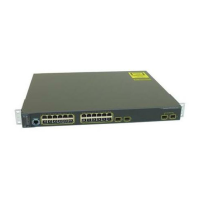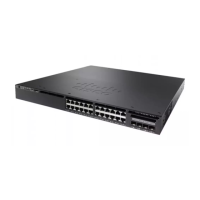Polarization As a By-Product of Using the S-Hash and Basic S-G-Hash Algorithms
The hash mechanism used in IPv4 multicast to load split multicast traffic by source address or by source and
group address is subject to a problem usually referred to as polarization. A by-product of ECMP multicast
load splitting based on source address or on source and group address, polarization is a problem that prevents
routers in some topologies from effectively utilizing all available paths for load splitting.
The figure illustrates a sample topology that is used in this section to explain the problem of polarization when
configuring ECMP multicast load splitting based on source address or on source and group address.
Although the following illustration and example uses routers in the configuration, any device (router or
switch) can be used.
Note
Figure 18: Polarization Topology
In the topology illustrated in the figure, notice that Router 7 has two equal-cost paths towards the sources, S1
to S10, through Router 5 and Router 6. For this topology, suppose that ECMP multicast load splitting is
enabled with the ip multicast multipath command on all routers in the topology. In that scenario, Router 7
would apply equal-cost load splitting to the 10 (S, G) states. The problem of polarization in this scenario
would affect Router 7 because that router would end up choosing serial interface 0 on Router 5 for sources
S1 to S5 and serial interface 1 on Router 6 for sources S6 to S10. The problem of polarization, furthermore,
would also affect Router 5 and Router 6 in this topology. Router 5 has two equal-cost paths for S1 to S5
through serial interface 0 on Router 1 and serial interface 1 on Router 2. Because Router 5 would apply the
same hash algorithm to select which of the two paths to use, it would end up using just one of these two
upstream paths for sources S1 to S5; that is, either all the traffic would flow across Router 1 and Router 5 or
across Router 2 and Router 5. It would be impossible in this topology to utilize Router 1 and Router 5 and
Router 2 and Router 5 for load splitting. Likewise, the polarization problem would apply to Router 3 and
Router 6 and Router 4 and Router 6; that is, it would be impossible in this topology to utilize both Router 3
and Router 6 and Router 4 and Router 6 for load splitting.
IP Multicast Routing Configuration Guide, Cisco IOS XE Release 3.6E (Catalyst 3850 Switches)
354 OL-32598-01
IP Multicast Optimization: IP Multicast Load Splitting across Equal-Cost Paths
Overview of ECMP Multicast Load Splitting
